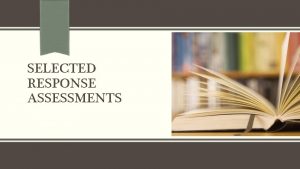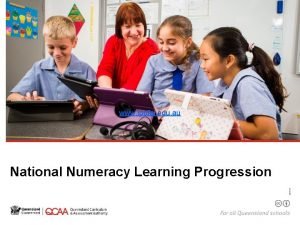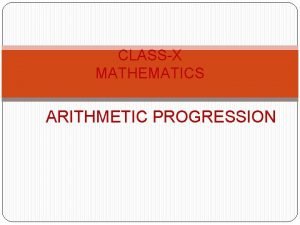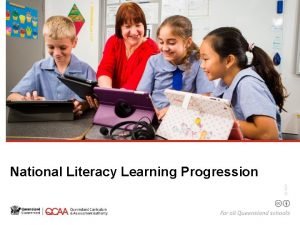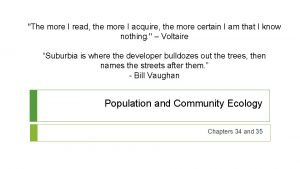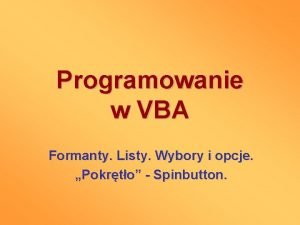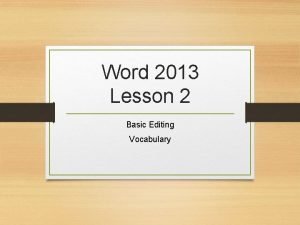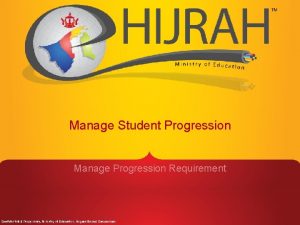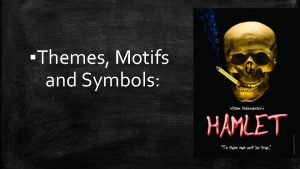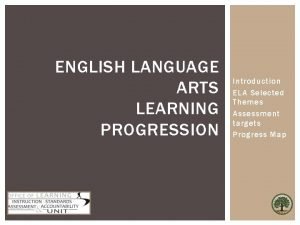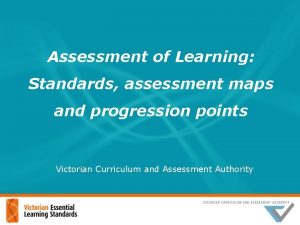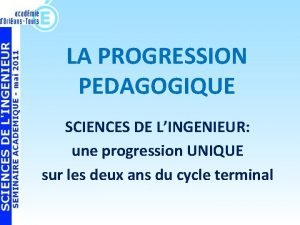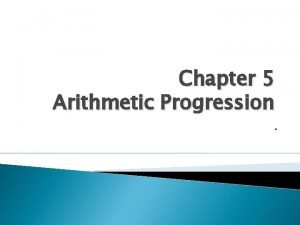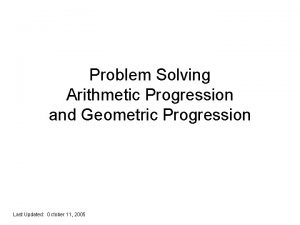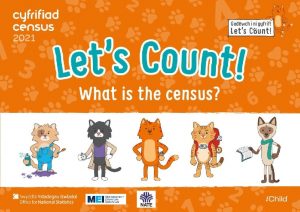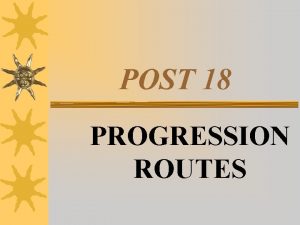MATH LEARNING PROGRESSION Introduction Math Selected Themes Assessment















- Slides: 15

MATH LEARNING PROGRESSION Introduction Math Selected Themes Assessment targets Progress Map

4 BUILDING BLOCKS Learning Progression Item Design Assessment Quality Outcomes/ Scoring

INTRODUCTION Bear Assessment System Stage 1 Focus on the process of learning and on individual student’s progress through that process Progress maps § At a grade level, a learning progression map can represent one content standard/cluster within which standards are ranked in the order of cognitive complexity § Across grade levels, a learning progression map represent several related content standards/clusters each of which standards are ranked in the order of cognitive complexity

HOW TO READ MATH STANDARDS Grade Level Domain Content standard (Cluster, containing a, b, c) Standard (8. EE. 8. c)

MATH SELECTED THEME Selected Theme: Problem-solving (Claim #2) Rationale: § Applies across all mathematics topics § Addresses mathematical practice § Allows for posing of non-traditional problem types

A GLIMPSE AT THE WHOLE LP! We’ll be looking at an example from this portion, upper elementary to middle school

EXAMPLE LP (UPPER ELEMENTARY AND MIDDLE SCHOOL; ALGEBRAIC PROBLEM SOLVING) Grade SBAT Specific Common Core Standards 8 8. EE. B Work with radicals and integer exponents (8. EE. 1 – 8. EE. 4). 8. EE. C Understand the connections between proportional relationships, lines, and linear equations (8. EE. 5 – 8. EE. 6). Analyze and solve linear equations and pairs of simultaneous linear equations (8. EE. 7 – 8. EE. 8 c). 7 7. EE. A Use properties of operations to generate equivalent expressions. Use 7. EE. B properties of operations to generate equivalent expressions (7. EE. 1 – 7. EE. 2). Solve real-life and mathematical problems using numerical and algebraic expressions and equations (7. EE. 3 – 7. EE. 4 b). 6 6. EE. A Apply and extend previous understandings of arithmetic to algebraic 6. EE. B expressions (6. EE. 1 – 6. EE. 4). 6. EE. C Reason about and solve one-variable equations and inequalities (6. EE. 5 – 6. EE. 8). Represent and analyze quantitative relationships between dependent and independent variables (6. EE. 9).

EXAMPLE LP (UPPER ELEMENTARY AND MIDDLE SCHOOL; ALGEBRAIC PROBLEM SOLVING) Grade 5 4 SBAT Specific Common Core Standards - Write and interpret numerical expressions (5. OA. 1 – 5. OA. 2). Analyze patterns and relationships (5. OA. 3). 4. OA. A Use the four operations with whole numbers to solve problems (4. OA. 1 – 4. OA. 3). Gain familiarity with factors and multiples (4. OA. 4). Generate and analyze patterns (4. OA. 5). Notes: OA = Operation and Algebraic Thinking domain EE = Expressions and Equations domain SBAT = Smarter Balanced Assessment Targets as required to achieve Claim #2

EXAMPLE LP (UPPER ELEMENTARY AND MIDDLE SCHOOL; ALGEBRAIC PROBLEM SOLVING) Grade SBAT 6 6. EE. A 6. EE. B 6. EE. C 5 - Specific Common Core Standards Apply and extend previous understandings of arithmetic to algebraic expressions (6. EE. 1 – 6. EE. 4). Reason about and solve one-variable equations and inequalities (6. EE. 5 – 6. EE. 8). Represent and analyze quantitative relationships between dependent and independent variables (6. EE. 9). Write and interpret numerical expressions (5. OA. 1 – 5. OA. 2). Analyze patterns and relationships (5. OA. 3).

EXAMPLE LP (UPPER ELEMENTARY AND MIDDLE SCHOOL; ALGEBRAIC PROBLEM SOLVING) Grade SBAT Specific Common Core Standards 7 7. EE. A Use properties of operations to generate equivalent 7. EE. B expressions. Use properties of operations to generate equivalent expressions (7. EE. 1 – 7. EE. 2). Solve real-life and mathematical problems using numerical and algebraic expressions and equations (7. EE. 3 – 7. EE. 4 b). 6 6. EE. A Apply and extend previous understandings of arithmetic to 6. EE. B algebraic expressions (6. EE. 1 – 6. EE. 4). 6. EE. C Reason about and solve one-variable equations and inequalities (6. EE. 5 – 6. EE. 8). Represent and analyze quantitative relationships between dependent and independent variables (6. EE. 9).

EXAMPLE LP (UPPER ELEMENTARY AND MIDDLE SCHOOL; ALGEBRAIC PROBLEM SOLVING) Grade SBAT Specific Common Core Standards 8 8. EE. B 8. EE. C Work with radicals and integer exponents (8. EE. 1 – 8. EE. 4). Understand the connections between proportional relationships, lines, and linear equations (8. EE. 5 – 8. EE. 6). Analyze and solve linear equations and pairs of simultaneous linear equations (8. EE. 7 – 8. EE. 8 c). 7 7. EE. A 7. EE. B Use properties of operations to generate equivalent expressions (7. EE. 1 – 7. EE. 2). Solve real-life and mathematical problems using numerical and algebraic expressions and equations (7. EE. 3 – 7. EE. 4 b).

ASSESSMENT TARGETS In SBAC, each claim has specific assessment targets Assessment targets for Claim #2 on problem solving: § A = Apply mathematics to solve well-posed problems in pure mathematics and those arising in everyday life, society, and the workplace (DOK 2, 3) § B = Select and use appropriate tools strategically. (DOK 1, 2) § C = Interpret results in the context of a situation. (DOK 2) § D = Identify important quantities in a practical situation and map their relationships (e. g. , using diagrams, two-way tables, graphs, flowcharts, or formulas). (DOK 1, 2, 3) DOK Depth of Knowledge as listed in the Cognitive Rigor Matrix (SBAC, 2012). Numbers represent level.

COGNITIVE RIGOR MATRIX

BIBLIOGRAPHY Common Core Standards Initiative. (2014). Common core standards for mathematics. Retrieved from http: //www. corestandards. org/Math/ Common Core Standards Initiative. (2014). Common core standards for English language arts & literacy in history/social studies, science, and technical subjects. Retrieved from http: //www. corestandards. org/ELA-Literacy/ Hess, K. , Carloc, D. , Jones, B. , & Walkup, J. , (2009). What exactly do “fewer, clearer, and higher standards” really look like in the classroom? Using a cognitive rigor matrix to analyze curriculum, plan lessons, and implement assessments. Paper presented at CCSSO, Detroit, Michigan. Oregon Department of Education. (2014, June). Assessment guidance. Webb, N. (2007). Aligning assessments and standards. Retrieved from http: //www. wcer. wisc. edu/news/cover. Stories/aligning_assessments_and_standards. p hp Wilson, M. (2005). Constructing measures: An item response modeling approach. New York: Psychology Press, Taylor & Francis Group. Wilson, M. , & Sloane, K. (2000). From principles to practice: An embedded assessment system. Applied Measurement in Education, 13 (2), pp. 181 -208. Smarter Balanced Assessment Consortium. (2012, April). General item specifications. Smarter Balanced Assessment Consortium. (2013, June). Content specifications for the summative assessment of the Common Core State Standards for Mathematics. Revised draft.

CREATIVE COMMONS LICENSE Introduction to Learning Progressions (Math) PPT by the Oregon Department of Education and Berkeley Evaluation and Assessment Research Center is licensed under a CC BY 4. 0. You are free to: Share — copy and redistribute the material in any medium or format Adapt — remix, transform, and build upon the material Under the following terms: Attribution — You must give appropriate credit, provide a link to the license, and indicate if changes were made. You may do so in any reasonable manner, but not in any way that suggests the licensor endorses you or your use. Non. Commercial — You may not use the material for commercial purposes. Share. Alike — If you remix, transform, or build upon the material, you must distribute your contributions under the same license as the original. Oregon Department of Education welcomes editing of these resources and would greatly appreciate being able to learn from the changes made. To share an edited version of this resource, please contact Cristen Mc. Lean, cristen. mclean@state. or. us.
 Selected response assessment
Selected response assessment Numeracy continuum acara
Numeracy continuum acara Arithmetic sequence conclusion
Arithmetic sequence conclusion National literacy progressions
National literacy progressions Cuadro comparativo e-learning b-learning m-learning
Cuadro comparativo e-learning b-learning m-learning Data gathering for quantitative research
Data gathering for quantitative research K selected species survivorship curve
K selected species survivorship curve Qualitative and quantitative research
Qualitative and quantitative research Vba combobox selected item
Vba combobox selected item K selected species survivorship curve
K selected species survivorship curve Example of r selected species
Example of r selected species Ounces of ice cream in a large milkshake
Ounces of ice cream in a large milkshake Removes selected text and places it on the clipboard
Removes selected text and places it on the clipboard Ann arbor mi population pyramid
Ann arbor mi population pyramid Neither of my two suitcases are adequate for this trip
Neither of my two suitcases are adequate for this trip How can you add a new costume of sprite
How can you add a new costume of sprite
